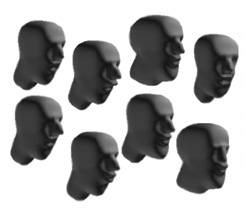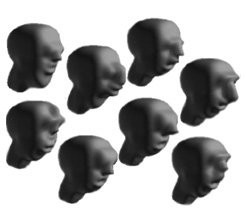
Interactive Construction of Smoothly Blended Star Solids
|
Ergun Akleman Visualization Laboratory Department of Architecture Texas A&M University |
Extended Abstract
Abstract
This paper introduces a computationally efficient method
for interactive
construction of implicitly represented star solids.
These solids smoothly approximate control shapes
that are defined by exact union and intersections
over half-spaces containing the origin.
Based on our algorithm, computation of a new solid shape
when a new half-space is added or when
the position of an existing half-space is changed
can be performed in constant time and
in space linear in the number of half-spaces.
Our implicit shape construction is based on a
family of non-polynomials called ray-linears .
Computation of an implicitly represented shape is a root
finding process and in general can be extremely difficult.
However since ray-linear implicit representations
can easily be parameterized,
the computation of any ray-linearly represented shape
simplifies to evaluation of a parametric equation
instead of root finding.
But the related parametric equations are non-polynomials and
their complexity increases as the number of
building blocks (in this case half-spaces) increases.
Our algorithm
makes the computation of this parametric equation independent
of the number of half-spaces.
We develop an interactive platform based on our algorithm
with which we are able to construct star solids that resemble human faces.
Introduction

|
| Figure 1: Interactively Generated Smoothly Blended Star Shapes. |
In this paper, we present a modeling tool based on ray-linears. This modeling tool provides interactive construction and manipulation of smoothly blended solids described by star shaped control polyhedra.
In our modeling tool, each detail of the shape is represented by one convex polyhedron and control of details is accomplished by interactively changing these convex polyhedra. Modifiying each convex polyhedron results in a different solid shape.
Control of blobby apperance is accomplished by changing blending parameters. These blending parameters smooth out the sharp edges and corners of the star shaped control polyhedron. There are two types of blending parameters: global and local. The global blending parameter smooths out sharp edges resulting from the exact union of convex polyhedra. Blobby effects come mostly from this global blending parameter. Local blending parameters smooth out sharp edges and corners of convex polyhedra that result from the intersection of half-spaces. Different combinations of global and local blending parameters create different looks. Generally speaking, we can say that more blended shapes look fleshier, whereas less blended shapes look more robotic and less organic.

|
| Figure 2: Interactively Generated Smoothly Blended Star Shapes. |
In this paper, we present a computationally efficient method to guarantee the interactive construction of ray-linearly represented solids. Based on our method, computation of a new solid shape when a new half-space is added or when the position of an existing half-space is changed can be performed in constant time and in space linear in the number of half-spaces.
The method we present here, by reusing the previous computation, makes the computation of these parametric equations independent of the number of half-spaces. As a result of this independency, when a user adds a new convex polyhedron or changes the position of a vertex of a convex polygon, a new solid shape can always be computed in constant time.
Conclusion and Discussion
We have developed an approach to make implicit modeling of smootly blending star shapes interactively. By using our approach, the shapes closely resembles to faces can be modeled interactively as shown in Figures 1 and 2.
In order to simplify the user interface we provide only a certain type of control polyhedra: those that are given as a union of convex polyhedra that are constructed by the union of two perpendicular prisms. We are planning to remove this restriction by using virtual reality tools to manipulate the half-spaces freely in three-dimensions.
Since we use half-spaces as building blocks the faces of the control shape have to be planar. However, in general this does not have to be the case. For instance, a cylinder can be a control solid since it is the exact intersection of an infinite cylinder and two half-spaces, and, both infinite cylinders and half-spaces can be described by ray-linear implicit representations.
By using ray-linears we are limited to star shapes. Due to this restriction over the control solid we cannot interactively construct all solid shapes. However, ray-linear implicit representations of the parts of a solid shape can be obtained by interactive construction. Once the ray-linear formulas for each part are obtained, we can combine these formulas by using Ricci's set operations.
It is also possible to use these formulas in other implicit representation based solid modeling tools such as constructive solid geometry, soft objects or Blinn's exponential equations. Since it is also possible to deform them, ray-linears can even be used as building blocks for applications that require shapes other than stars.
The operations over ray-linear representations of half-spaces are closely related to the super-elliptic local blending of Rockwood and convex superquadrics are a subset of ray-linears that are obtained by the approximate union operations over ray-linear representations of infinite symmetric stripes. Ray-linears are different than hyperquadrics which are a superset of superquadrics. Whereas hyperquadrics generalize superquadrics by going to higher-dimensions, ray-linears arise by introducing non-homogeneous functions. Another property of our modeling tool is that the data requested for representation of a facial model are limited. Less than fifteen convex polyhedra are enough for one face. Each convex polyhedron can be given by intersection of approximately ten half spaces. Each half-space can be described by two coefficients. These coefficients can be represented with just one byte since these solid shapes are quite robust (small changes in coeeficients do not change the shape).